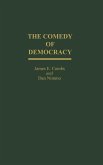Drawing on the new physics as the scientific foundation of transformational politics, Becker and Slaton write compellingly about teledemocracy, social energy, and democratic quanta. They outline their quantum political theory in rich detail, demonstrating how we have entered a phase of highly charged, erratic, and sometimes self-contradictory packets of social political energy that appears to occur with a rough regularity but with differing levels of velocity and force. Becker and Slaton explore the current state and future of televoting, electronic town meetings, and other initiatives designed to put the public back into public affairs. This book will prove to be a fascinating read for scholars, students, researchers, and policymakers interested in new political paradigms, politics, and public administration.
Hinweis: Dieser Artikel kann nur an eine deutsche Lieferadresse ausgeliefert werden.
Hinweis: Dieser Artikel kann nur an eine deutsche Lieferadresse ausgeliefert werden.








